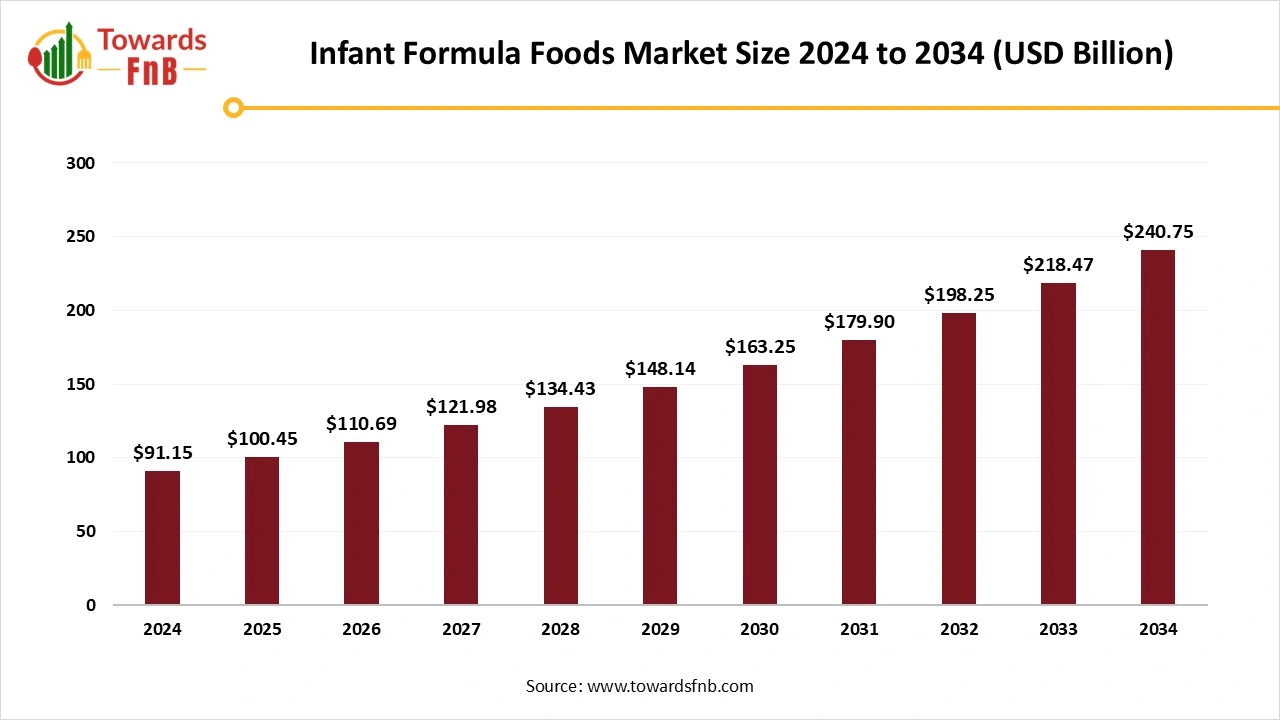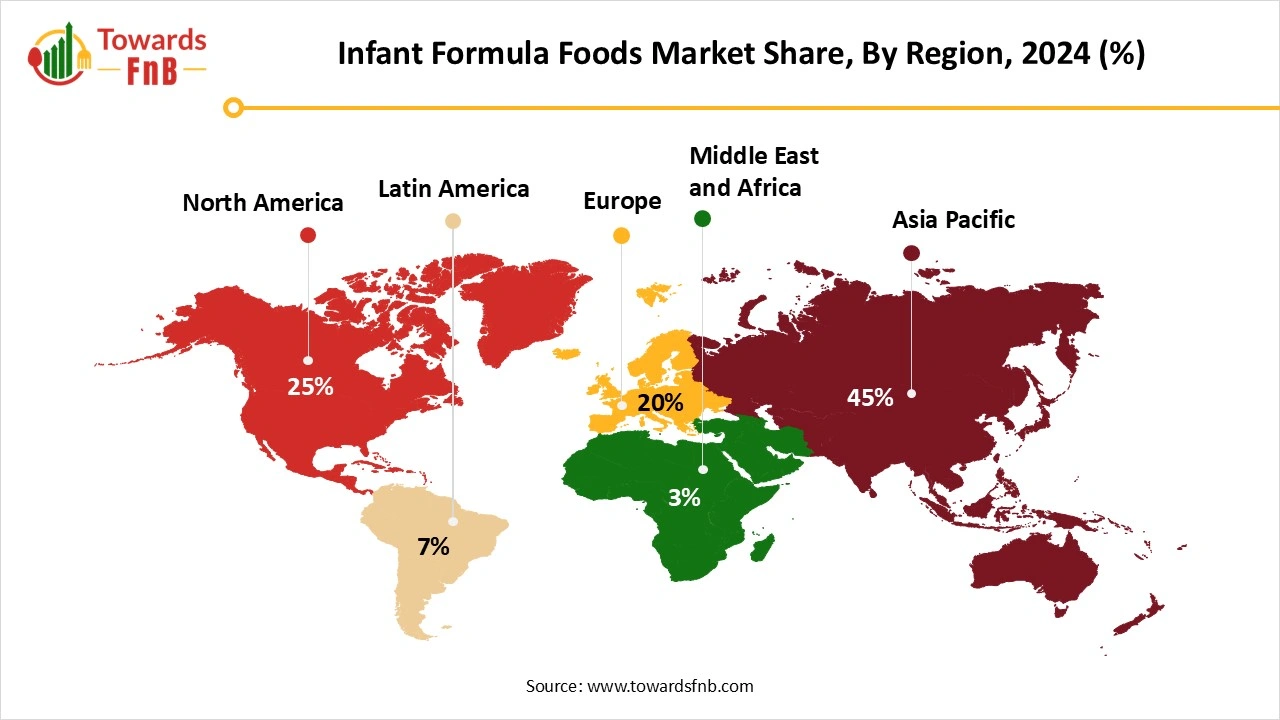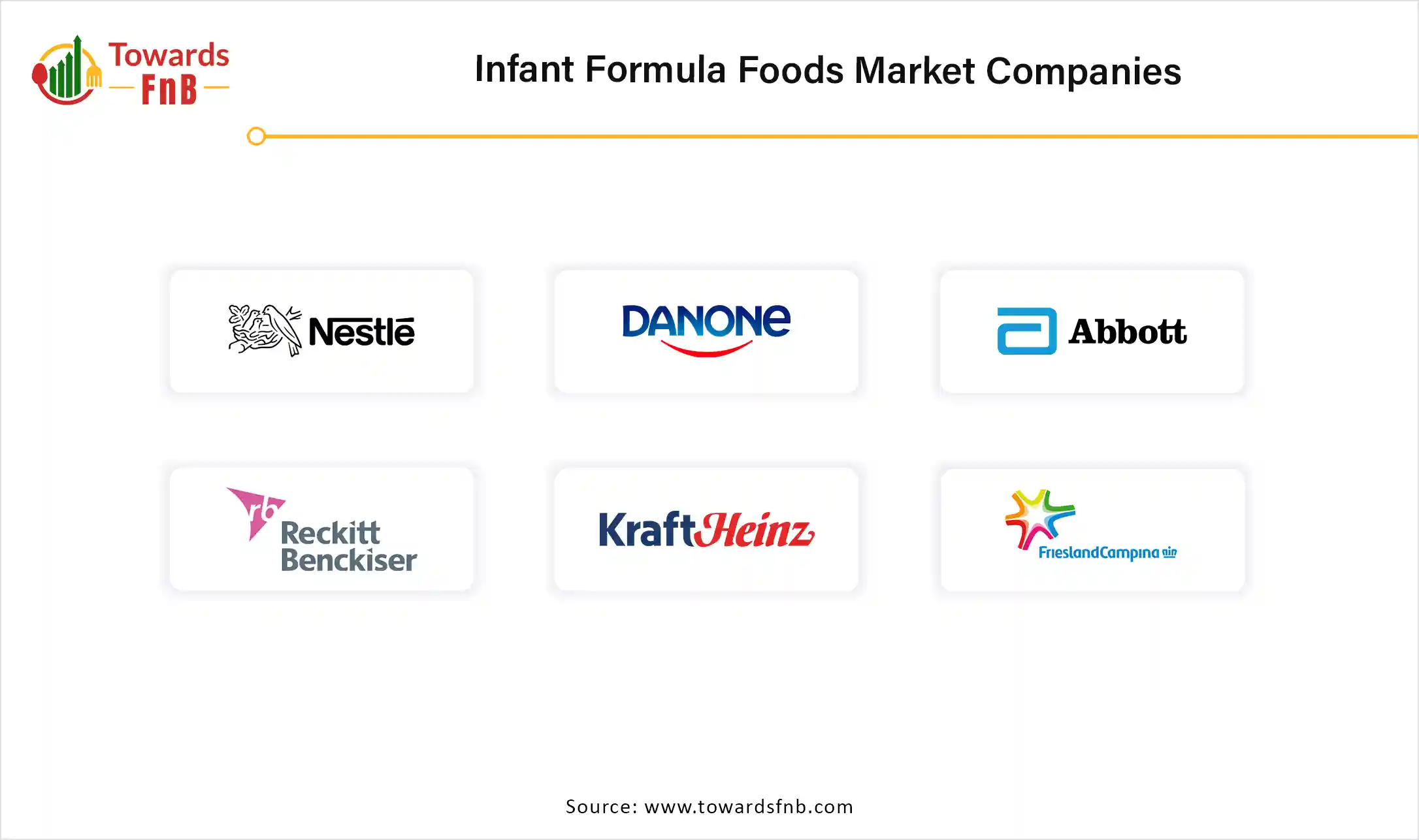November 2025
The global infant formula foods market size was reached at USD 91.15 billion in 2024 and is expected to touch from USD 100.45 billion in 2025 to nearly reaching USD 240.75 billion by 2034, growing at a CAGR of 10.2% during the forecast period from 2025 to 2034. The global infant formula foods market is attributed to the increasing demand for infant nutrition products.

| Study Coverage | Details |
| Growth Rate from 2025 to 2034 | CAGR of 10.2% |
| Market Size in 2025 | USD 100.45 Billion |
| Market Size in 2026 | USD 110.69 Billion |
| Market Size by 2034 | USD 240.75 Billion |
| Largest Market | Asia Pacific |
| Base Year | 2024 |
| Forecast Period | 2025 to 2034 |
| Regions Covered | North America, Europe, Asia-Pacific, Latin America, and Middle East & Africa |
The global infant formula foods market comprises specially formulated food products designed to meet the nutritional requirements of infants (generally 0–36 months) who are either breastfed or partially breastfed. These formulas mimic the composition of human breast milk and are enriched with essential nutrients like proteins, fats, vitamins, and minerals. Infant formula serves as a substitute or supplement to breast milk and comes in various formulations tailored for different infant needs and developmental stages.
There are significant advantages driving the growth of the infant formula foods market, such as age-appropriate foods, nutrient-rich properties, cost-effectiveness and storage, and safety. Infant formula foods provide an opportunity to improve nutritional content. It helps to maintain freshness and safety. To nourish infants, it also provides a wholesome and budget-friendly approach. By mastering age-appropriate recipes and incorporating key nutritional formulas, parents can rapidly contribute to their infant’s growth and development, which is further expected to drive the growth of the infant formula foods market.
The rising advancements in data and technology allow personalized infant food formulas based on nutritional demands, allergies, and age. The increasing preference towards functional nutritional foods with immune-boosting products, vitamins, iron, DHA, and probiotics is expected to present significant opportunities in the global market. In addition, the increasing growth of online distribution channels and growing e-commerce platforms enable parents to shop online for infant formulas that are ready-to-make and convenient for infants, which further expected to further revolutionize the growth of the infant formula foods market in the coming years.
One of the major challenges restraining market growth is the increasing high cost of formula foods and high regulatory standards. Due to the health sensitivity of formula foods, infant foods are subject to strict government regulations and safety standards, which may create major challenges. Dealing with labeling laws, ingredient restrictions, and testing requirements may cause costs and production complexity. In addition, organic and fortified formula foods may have high costs, which made low-class and middle-class populations cannot afford especially in developing economies, which further expected to further restrain the growth of the infant formula foods market.
How Asia Pacific Dominates the Market Revenue in 2024?
Asia Pacific dominated the infant formula foods market in 2024. The market growth in the region is driven by the increasing demand for organic and clean-label infant formula products, increasing disposable incomes, increasing rapid urbanization, increasing working women population, increasing busy lifestyles, and increasing parents’ awareness towards health and wellbeing. India, China, Japan, and South Korea are dominating countries, propelling the market growth.

India dominated the infant formula foods market in 2024. The government in India helps ensure that infants receive sufficient nutritious formula, preventive care, and remedial treatment for infants’ growth and development, which may accelerate the market demand in India. To improve home visits, community-based events, and monitor growth and weight, UNICEF India offers essential infant formula services and improves health facilities. In addition, every infant and child has the right to good nutrition formulas, according to the "Convention on the Rights of the Child". Around 35.9% infants are mixed-fed, 42.7% of children are breastfed, and 21.4% are formula-fed in India. Nestle NanPro is a widely used infant formula food in India. About 49.15% of parents chose formula feeding voluntarily, due to the insufficient milk supply.
North America Infant Formula Foods Market Trends
North America is expected to grow fastest during the forecast period. The market growth in the region is driven by factors such as the increasing consumer preference towards ready-to-drink and ready-to-make infant formula products, increasing busy lifestyles, growing working women population, increasing government initiatives, and rising technological advancements in infant products. The U.S. and Canada are the fastest growing countries, propelling the market growth in the region.
The U.S. is expected to grow fastest during the forecast period. Various consumers are based on infant formula for their nutritious food in the U.S. To address all the needs of infants, there are a various number of infant formula products sold in the U.S. Parents can order imported products online and direct-to-consumers, which may drive the growth of the infant formula foods market in the U.S.
How Infant Milk Formula (0-6 months) Segment Dominates Market Revenue in 2024?
The infant milk formula (0-6 months) segment dominated the infant formula foods market in 2024. The segment growth in the global market is attributed to the rising urbanization, increasing working women population, increasing demand for nutritious formulas, rising introduction of hospital-based formulas, rising birth rates in emerging countries, and increasing safety concerns among parents. Formula is a safe and healthy alternative for babies from 0-6 months. The infant milk formula is a suitable alternative for infants. A healthy baby requires about 150 ml of prepared formula per kg of body weight, from 5 days to 3 months, which may increase the demand for formula milk across the globe.
Why did Powdered Formula Segment Held the Largest Market Revenue in 2024?
The powdered formula segment dominated the infant formula foods market in 2024. The segment growth in the global market is driven by the longer shelf life, increasing demand for e-commerce services, increasing parents’ preference towards trustworthy and measured options, and increasing awareness towards health and wellness. Furthermore, powdered infant formula is consumed rapidly, due to its ease of storage and convenience.
By combining it with either water or milk, the infant formula in powdered form can be made. This powdered formula preserves all the product's nutrients through the freeze-drying procedure. This formula is affordable compared to other infant formulas. In addition, without error for each feeding, the powdered infant formula enables parents to regulate and measure the precise amount of baby formula, which is expected to accelerate the segment growth.
What Factors Help Cow Milk-based Segment Grow in 2024?
The cow milk-based segment dominated the infant formula foods market in 2024. The cow milk-based formula is a great source of calories, calcium, and protein for growing children. There are various health benefits of cow’s milk, such as promoting a healthy heart, better immunity, essential for the nervous system and brain cells, helping infants to make stronger teeth, and helping infants to grow taller, which is expected to drive the segment growth in the global market.
Why did Supermarkets/Hypermarkets Segment Held the largest Market Revenue in 2024?
The supermarkets and hypermarkets segment dominated the infant formula foods market in 2024. The segment growth in the global market is attributed to the increasing consumer trust, increasing demand for promotional activities and in-store marketing, increasing consumer preference towards offline stores, and increasing consumer desire to purchase infant foods physically without waiting for delivery.
The supermarkets and hypermarkets segment is convenient for shopping for infant formula food. It has an extended shelf life. Parents can feel more comfortable and satisfied while shopping offline with these channels, which is further expected to enhance segment growth in the global market.
What Factors are Driving the Demand for Infant Formula in Cans or Tins in 2024?
The cans and tins segment dominated the infant formula foods market in 2024. Canned and tinned food offers sound nutrition to help consumers achieve their nutritional demands. Canned and tin infant foods are filled with necessary nutrients, such as fiber, proteins, vitamins, and minerals, which are essential for a healthy diet. Canned infant formula food may reduce sodium options, as it contains less than 1% sodium.
An instant drain and rinse can reduce sodium content by 41% which can be nutritious and healthy for infants. In addition, Canned infant formula food is convenient, pre-cooked, baby-friendly texture and cost-effective, which further enhances nutrient content, further expected to accelerate the demand for cans and tins in the global market.
How Standard Nutrition Segment Dominates the Market Revenue in 2024?
The standard nutrition segment dominated the infant formula foods market in 2024. Standard nutrition is necessary for the development and growth of infants. The infant’s health is promoted when developing infants are fed the proper amounts and types of foods. Infants need energy from formula food for normal development, growth, and activity. In addition, the rising product enhancements in breast milk, increasing support from hospitals, rising growth in e-commerce platforms, and increasing parents' awareness towards infants’ health and well-being, which further expected to further accelerate the demand for standard nutrition.
Why Normal Birth Infants Segment Dominates the Market Revenue in 2024?
The normal birth infants segment dominated the infant formula foods market in 2024. The segment growth in the global market is driven by factors such as the increasing adoption of stage-based formulas, increasing demand for organic and clean-label products, increasing focus on immune and cognitive health products, rising innovations in packaging and convenience, rising research and development activities, and rising growth in e-commerce platforms.
Bobbie Labs
Iceland

By Product Type
By Form
By Ingredient Source
By Distribution Channel
By Packaging Type
By Functionality
By End-user Demographics
By Region
The global halal food and beverage market size is expected to grow from USD 2.72 trillion in 2025 to USD 5.44 trillion by 2034, at a CAGR of 8% over t...
The U.S. private label food and beverages market is rising from USD 163.93 million in 2025 to USD 447.34 million by 2034. This projected expansion ref...
November 2025
October 2025
October 2025
September 2025